The Big Interview
‘I’ve Learned to Lean on God’: Rising Artist Genesis Tramaine on How She Channels Her Christian Faith Into Ecstatic Portraits
Tramaine recently sat down with the Art Angle podcast to take about faith and art.
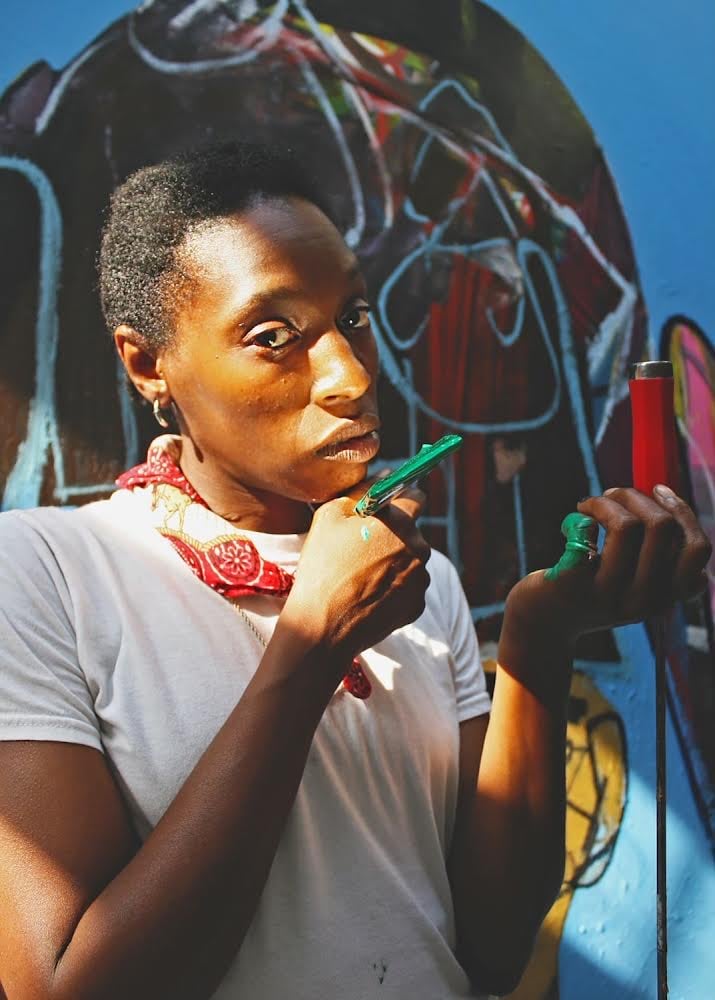
Tramaine recently sat down with the Art Angle podcast to take about faith and art.

Katie White

Painter Genesis Tramaine is proudly Black, unapologetically queer, and—unusual for the world of contemporary art—a vocal Christian who makes no bones about the divine sources of her inspiration. Her expressionistic devotional portraits, which garnered notice in “God Is Trans,” her 2018 solo exhibition at Brooklyn’s Richard Beavers Gallery, are anything but doctrinaire, presenting saints and biblical figures with graffiti-inflected urgency and eye-popping color.
In this week’s Art Angle podcast, Tramaine chats about sibling rivalry in the Bible, how her faith intersects with her paintings, and the work she is excited to show with her gallery, Almine Rech, at the Armory Show this week (September 9–12).
A version of this conversation originally aired on The Art Angle Podcast, available in full here.
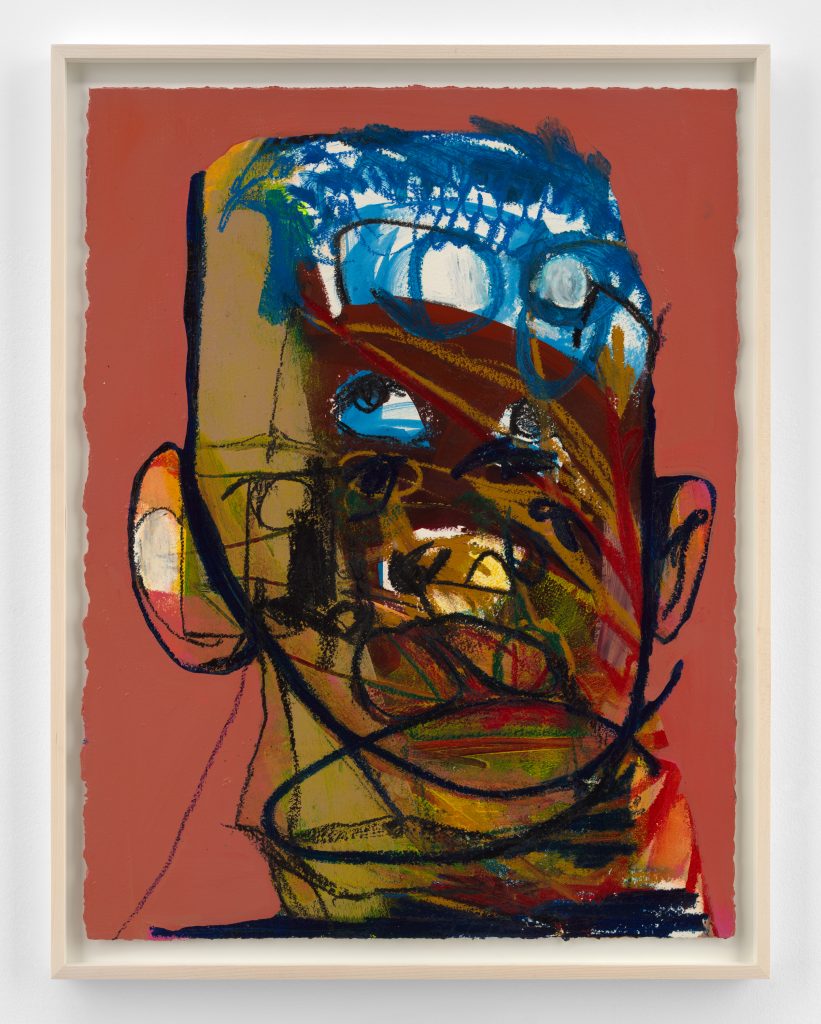
Genesis Tramaine, Jesus Loves me: Still (2021), whose listed materials include spray paint and the Holy Spirit. Courtesy of the artist and Almine Rech.
Is it true that you actually started drawing in church to keep yourself quiet when you were a little kid? Can you tell me more about that and how your art-making has kind of always been intertwined with religion?
I’ve always been a doodler, if you would. But when I was in church, sure enough, I was a talker. You know, I would get up and clap and sing at times that maybe weren’t the most appropriate. And I was often instructed to sit on the back pew, [where] I would sketch inside of the hymn books. I would sketch inside of the Bibles, that’s true. I found a love for trying to keep up with the energy that the gospel fed me…I liked that it was able to produce something that didn’t look like anything else. So I don’t know if it was a specific religion, but I do know that it was wrapped in a very Black discipline, if you would, of being quiet and listening to the good word while it’s spread.
Your grandmother was a big inspiration for your 2020 exhibition “Parables of Nana” at Almine Rech, and your mother is a gospel-music enthusiast. Can you talk about the women in your family and the role of faith when you were growing up?
I wouldn’t be who I am without those very intentional—intense, if you would—lessons from my grandmother and mom. I don’t come from material wealth, I do come from cultural wealth. I was taught in order to produce a greater relationship with God, you have to have faith, and that means that you believe in things that you don’t necessarily see in front of you. I have a vast imagination due to that discipline of faith-building that my family enriched in me. So yeah, I do walk with a lot of that.
I’ve learned to lean on God in spaces where I don’t understand. My role with Christ hasn’t always been clear. Whether or not I can have a relationship hasn’t always been clear. So those early sayings and instructions and whispers from my grandmother and mother play over and over in my head, you know, Now I lay me down to sleep, I pray my Lord, my soul to keep…those early prayers that my mom and grandmama taught me are still rich in my heart and in very rich in my work, I’d say.
Can you talk a little bit about your journey to an open embrace of Christianity and ultimately handing over your inspiration to God?
I taught high-school math for many years, algebra in particular. I love the field of education and I believe that I have gained so much in those years of service, creatively. My students taught me so, so much…but I wanted to give the world more. I prayed to God to work through those spaces of service so that I could lean into the lane of art from a professional space.
That sort of 30-year-old point in your life had hit me really hard, and I realized that I hadn’t been to church in a while. I was welcomed by Unity Fellowship Church. I’ve spread my wings there—I paint live, sketch live, pray live. My ministry, if you would, has been allowed to flourish there, but it has not always been welcomed in traditional churches. I’ve been called out on pews. I’ve walked into many churches with my wife and unfortunately not always been loved on immediately. I don’t speak harshly on those church experiences, because we are people, and I think that sometimes it’s not easy to accept difference. So I’m grateful that God has given me art, because it creates a lane for me where those two things are very necessary.
As a queer married woman, how do you think that part of your identity has influenced your faith? Or does it give you a different aspect to your faith?
Absolutely. I have a wife. Oh my goodness, I have a Black, beautiful wife! She’s such a stone. Man, she’s such a partner to march with. So that makes my day-to-day just easier, to be honest. It’s all out and open and public, because that’s very much in accordance with how the relationship that I have with Jesus is, right? Like, there are no secrets between us. I have faith that I get to be all of who I am under the eyes of God, in the name of Jesus.
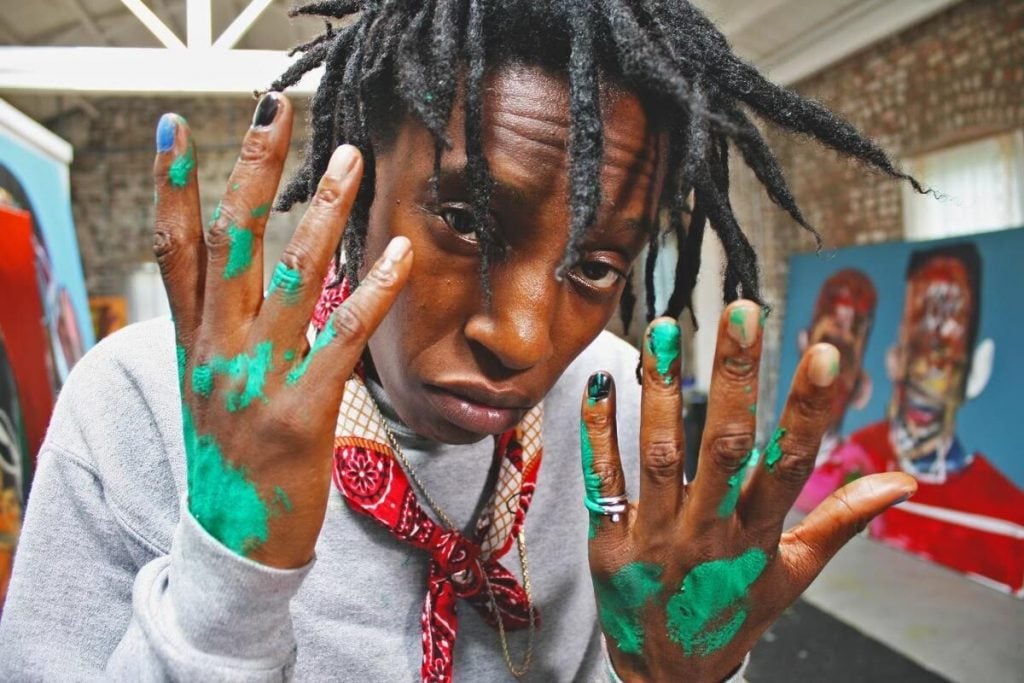
Artist Genesis Tramaine in her studio. Photo: Ashley Dennis.
What is the feeling you’re waiting for when you’re going to make an artwork? How do you tap into it?
It’s a walk with, sister. It’s not a tap in, ’cause I need God all the time, sis. I mess up so much—we human, we built to mess up—so I’d rather have God all the time. And I’ve learned that I need to be a constant listener. The best way I can describe it is like maybe the way a doctor would feel when they’re on-call—you know, always available. So when the good Lord taps my left shoulder and says, Let’s get up and go, you know, I get up and go. And it’s not always paint that’s involved in that get-up-and-go, it’s just answering that call.
Many of your paintings are reflections on saints, and your series “Evidence of Grace” is filled with images of King David. Can you talk about the scenes or biblical figures you chose, and why you think painting them is important?
I read the word a lot because it’s important, and it also builds a great understanding for me within myself, like, why am I interested in this relationship with God at all? I’m constantly in rhythm and flow with How can I get closer, how can I get deeper? I tend to sketch through my receiving of most things. So as I read through the word, I write questions down, I write pictures down. I pray through that space. And then I circle names in the word, and sometimes that practice lands on the canvas.
I think it’s important that you paint a real narrative, an honest reflection. I don’t think [my saints] look like saints as they have been given to us…[those] were false narratives. They were paid for by very wealthy conglomerates, similar to the way things are now. It’s just that this Black face has a little bit more control over what happens in the studio. I can be completely honest in my delivery.
So the saints, they’re rich with gospels that are necessary for this generation and the ones that are to come. It’s a painted language, sister. It surpasses our literal language. Sometimes it’s easy to understand and sometimes it goes right over my head. It’s interesting to be given a responsibility to paint for the future.
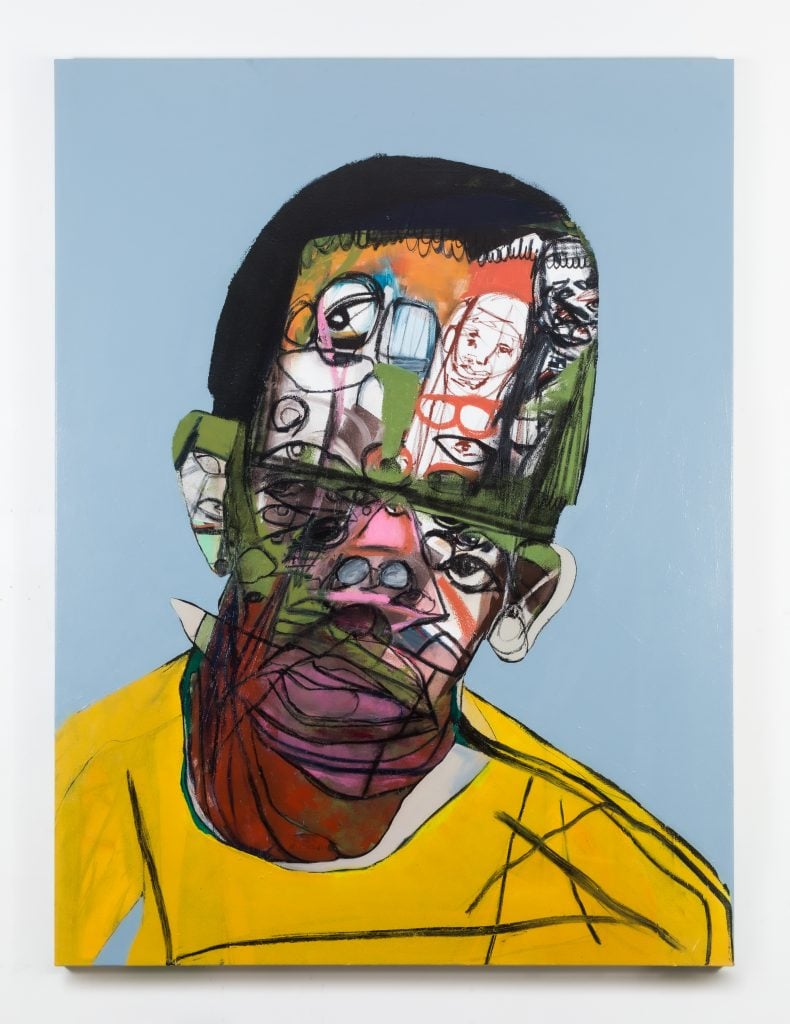
Genesis Tramaine, Saint Boaz In the Field (2021), will be presented by Almine Rech at the Armory Show, September 9–12, 2021. Photo by Charles Roussel/OCULA.
Are there particular figures from the Bible or saints that you identify with personally?
I love all of them. When I was in David, I was like David for a while. And then I was like Goliath for a while. I play the bad guy too. Sometimes I’m a little more assertive behind the driving wheel than I need to be—I have Goliath days, you know?
Right now, I’m reading through Ruth. Oh my goodness, I cannot wait for you guys to see this work that is coming, honey! To paint portraits as they come to me truly is to occupy the space as I would a dance. That’s what it looks like when I’m painting: If you were to turn on a video and record me, you’d see that for me, praying looks like dancing. So in order to occupy that space fluidly, I believe you have to really just allow the word in. That energy, oh man, it fuels the work because it fuels my prayers, you understand?
Why painting and not another medium?
You travel with paper when you’re a schoolgirl. You have an ink pen, you have a pencil…the very moment I got a chance to create with paint, I did. And then I ran out, sis, ‘cause paint is expensive! And I paint heavy. I drip heavy. My mom and my grandma, they’re like, ‘Listen, we just bought you this sketchbook, child. How many sketchpads do you need?’ I don’t know if you guys remember those Crayola watercolor packs?
Oh yeah, I do. I do.
So you know they’re hard when you get them; you have to add water in order for the color to work. Well, I was taught to add all types of things in order to thicken the medium, and how to manipulate it with just that little color block. I’ve always just loved it, and I think my family supported me by showing me how to do little tricks with it, with the things that we had. I’ve learned that that’s the wealth. That that was the thing that I could take to God and ask God to enlarge, if you would. And to God be glory, here we are, sister.
You are a gospel-music enthusiast, so who are your favorite musicians right now? What are you listening to?
Right now, Jonathan McReynolds. I think he’s a brilliant writer and singer. I really, really enjoy Shirley Caesar. I’ve been running Aretha Franklin’s Amazing Grace. I listen to contemporary gospel. Tramaine Hawkins, I was named after her. Those are some of my favorites that are coming to mind right now.
Are there any fine artists that you find particularly inspiring, contemporary or otherwise?
Hilma af Klint at the Guggenheim is the one that I always sort of go to because I really had an exchange with the work. At the time, I wasn’t painting at such a large scale, so I just admired her breadth. Oh man, I just really enjoyed the experience that I had with the paintings. Yeah. Wow. And of course, Barkley Hendricks, whose work I just—you know, wow. Wow. Wow. So those are some that I’ve sat in front of and had to step back, you know, before I step forward, to step back before I step forward. Oh, that’s a good dance before a painting.
Were people surprised when you first started talking about Jesus with your work, or has it mostly been a positive reception?
It has mostly been uplifting. Here’s the thing I’ve learned, sis: the more vulnerable I am with this work, the more vulnerably I’m received. So even if it’s a ‘negative’ response…it doesn’t have to be all bad. Sometimes people don’t have the language to express confusion. Sometimes people don’t have the language to express love. If I weren’t built for this, God wouldn’t have put me here. I love the flow of the conversation. I pray to be available for all of it. I think I have a responsibility—I don’t think I always just get to sit with this prayer life by myself. I want to share it.
Do you think that your artwork can be understood outside of the context of faith?
Yes, of course. It’s colorful. It’s large. It’s a portrait. The colors have sound, if you listen close enough. I’m looking at some of the portraits that I just finished…the layers have stories and narratives that may remind you of things, or not. So, yes: I think if you like new things, if you like creative things, if you like round things or square things, or if you like things with shapes, or if you like things that jump off of a page, if you like something other than the norm, I think that you’ll lean into my work.
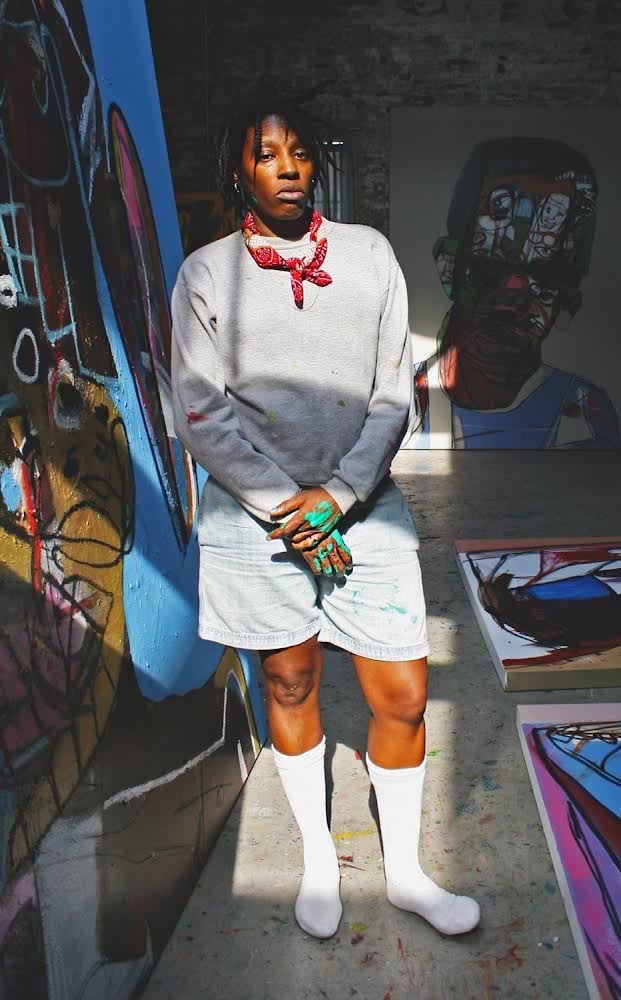
Artist Genesis Tramaine in her studio. Photo: Ashley Dennis.
Your show “Evidence of Grace” dealt with the Black Lives Matter movement and the coronavirus. Where are you headed now?
We are rolling through such an interesting storm. I use ‘rolling’ lightly, because sometimes it’s felt like a floating ship, and sometimes it feels like a sinking boat. Sometimes I feel like Jonah. Today I woke up feeling good. When I get off with you guys, I’m going to pray and then I’m going to hit the studio. That’s where I’m at today.
[This week] I’ll be showing at the Armory Show with Almine Rech, and I’m really excited for the work. That’s what’s in the back of my mind, I know that’s happening. I’m really hoping that I get down to Miami in December, hopefully for Art Basel. I’m currently showing with the Rubell Museum. I’ll probably be there, maybe God willing!
There’s so much uncertainty about what will happen. Can you tell me a little bit about your residency at the Rubell Museum?
I was invited to come down to paint some portraits. I met Mera and Don Rubell, and they welcomed me with open arms and introduced me to a prayer space and a studio space and the beach. Those were my grounds for the most of the time that I was there. And I was able to produce really beautiful works, a series called “Sanctuary.”
I was in Genesis and I was reading about these two brothers, Jacob and Esau. I just fell in love with their story. It allowed me to lean into the grace of God a little bit closer through something that was really relatable. There are these two brothers that are twins, and one has favor with mom and one has favor with dad.
There is a lot of sibling rivalry in the Bible.
There is, but there’s a lot of sibling rivalry in the world, you know? So it’s interesting how reflective it is.
I gave the residency everything I had, and I was given room to do so. One of my favorite parts was the exchange that I was afforded with the Rubells. I was poured into, and it was nice to be treated with such kindness. The director, Juan, was also just such a friend, literally—sometimes it’s those pockets of joy or gifts from God, truly. I was grateful for them because it was a really tumultuous time in our world.
I have heard repeatedly that you are a morning person. Why are you a morning person? What do you like about the morning?
The world tends to be more quiet in the morning. It’s easier for me to center myself. I don’t wake up to alarm clocks. I wake up when woken up—when the spirit taps, I’m up, and that tends to be early. For a long time, I questioned it. I would paint through the night and I thought that’s what I was supposed to be doing. [Now] if I’m up at 5 a.m., I go into prayer so that I can be ready when the good Lord calls me. It’s a very healthy practice. I get to see sunrises that I don’t hit on Instagram. I invite you, for real—if you can do it for 30 days, just wake up at like, 6 a.m.
Okay, I’ll start with 6 a.m. We’ll start with 6 a.m.
Baby steps, right?